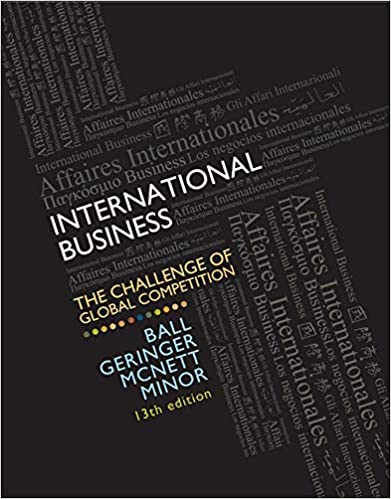
International Business 13th Edition by Donald Ball,Michael Geringer,Michael Minor ,Jeanne McNett
Edition 13ISBN: 978-0077606121
International Business 13th Edition by Donald Ball,Michael Geringer,Michael Minor ,Jeanne McNett
Edition 13ISBN: 978-0077606121 Exercise 1
Is Offshore Outsourcing Ending Its Run?
In 2003, nearly 900 workers at a cookware factory in Manitowoc, Wisconsin, switched off their machines. Their company was moving operations to Mexico. Now, however, many of the same workers are back, this time making pots and pans for Brazilian cookware maker Tramontina. Increasing growth in demand resulted in Tramontina acquiring land and building additional production facilities to allow a doubling of production output. In Japan, Sharp Corporation built a $9 billion factory complex that is the largest LCD and solar panel plant in the world. When plans for the plant were first announced, the trend in Japan was to build manufacturing offshore in places like China. But Sharp's chairman wanted to manufacture at home, and the company even included factories for many of its suppliers in its plans for the site. Sharp is bucking current trends in two directions. First, it is concentrating on manufacturing, rather than outsourcing production and concentrating on design and marketing. Second, it is building new production facilities in a high-cost country rather than in a low-cost area. So it is running against both the trend to outsource production and to "offshore" that production. In many economically developed countries, governments are offering a range of incentives to attract and retain jobs in manufacturing and other sectors of the economy.
This may represent a trend toward HCCS-high-cost country sourcing. The idea here is that being "at home," or in some cases "closer to home," may provide advantages, or at least make offshore production less attractive. First, as the cost of transportation increases, staying closer to home may become more economical. Second, while the labor costs of LCCS (low-cost country sourcing) will probably always be a reason to offshore, producing closer to home allows better control of quality and service. One furniture maker in Manitowoc says he can offer 150 different colors of furniture, a variety that is possible because he does not have to produce months in advance in order to bring product from offshore. As manufacturing moves from make-to-stock, repetitive production to more flexible approaches, other industries may find themselves in this situation.
In the first quarter of 2011, the total value of outsourcing contracts was $17.5 billion, a decline of 28 percent from the first quarter of 2010 and 25 percent below the last quarter of 2010. However, developments such as cloud computing, increased used of multiple-source supply systems, and risk management provide indications that extensive outsourcing and offshoring activity will continue. But only about 35 percent of outsourcing proposals directly met buyers' objectives, and outsourcing contracts generally appear to be decreasing in terms of average duration and contract value.
What factors will determine whether or not more manufacturing and other activities will remain in-or come back to-high-cost countries such as the United States in coming years?
In 2003, nearly 900 workers at a cookware factory in Manitowoc, Wisconsin, switched off their machines. Their company was moving operations to Mexico. Now, however, many of the same workers are back, this time making pots and pans for Brazilian cookware maker Tramontina. Increasing growth in demand resulted in Tramontina acquiring land and building additional production facilities to allow a doubling of production output. In Japan, Sharp Corporation built a $9 billion factory complex that is the largest LCD and solar panel plant in the world. When plans for the plant were first announced, the trend in Japan was to build manufacturing offshore in places like China. But Sharp's chairman wanted to manufacture at home, and the company even included factories for many of its suppliers in its plans for the site. Sharp is bucking current trends in two directions. First, it is concentrating on manufacturing, rather than outsourcing production and concentrating on design and marketing. Second, it is building new production facilities in a high-cost country rather than in a low-cost area. So it is running against both the trend to outsource production and to "offshore" that production. In many economically developed countries, governments are offering a range of incentives to attract and retain jobs in manufacturing and other sectors of the economy.
This may represent a trend toward HCCS-high-cost country sourcing. The idea here is that being "at home," or in some cases "closer to home," may provide advantages, or at least make offshore production less attractive. First, as the cost of transportation increases, staying closer to home may become more economical. Second, while the labor costs of LCCS (low-cost country sourcing) will probably always be a reason to offshore, producing closer to home allows better control of quality and service. One furniture maker in Manitowoc says he can offer 150 different colors of furniture, a variety that is possible because he does not have to produce months in advance in order to bring product from offshore. As manufacturing moves from make-to-stock, repetitive production to more flexible approaches, other industries may find themselves in this situation.
In the first quarter of 2011, the total value of outsourcing contracts was $17.5 billion, a decline of 28 percent from the first quarter of 2010 and 25 percent below the last quarter of 2010. However, developments such as cloud computing, increased used of multiple-source supply systems, and risk management provide indications that extensive outsourcing and offshoring activity will continue. But only about 35 percent of outsourcing proposals directly met buyers' objectives, and outsourcing contracts generally appear to be decreasing in terms of average duration and contract value.
What factors will determine whether or not more manufacturing and other activities will remain in-or come back to-high-cost countries such as the United States in coming years?
Explanation
This Global Gauntlet explores "Is Offsho...
International Business 13th Edition by Donald Ball,Michael Geringer,Michael Minor ,Jeanne McNett
Why don’t you like this exercise?
Other Minimum 8 character and maximum 255 character
Character 255


